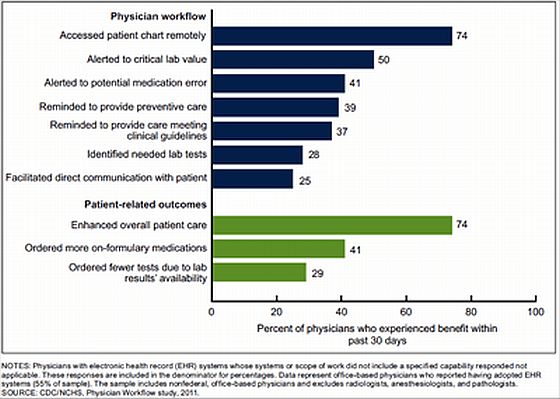If you work in the US Healthcare System, you know firsthand how much of a burden paperwork can be. The Paperwork Reduction Act of 1995 actually appears to have magnified the burden. Additional legislation passed in 2009 and with the Affordable Care Act in 2010, mandated and gave incentive for healthcare providers to transition to Electronic Healthcare Record (EHR) systems. In many cases, EHR systems were implemented based on work processes tied to desktop computers and peripherals.
Conversely, the full power of mobile devices really only started to show around 2013. Mobile apps and devices enable solutions not practical for desktop computers.
Mobile is about portability, with today’s devices having much the same, or even more, computing power than desktop computers had a decade ago. Paperwork collects information others need – physicians, patients, insurance companies, pharmacists, etc. Mobile technologies make collecting and communicating that information easier.
So, this gives a good reason for executives and managers in healthcare-related companies to take another look at:
- How big is the paperwork problem and why?
- What are the operational and financial benefits of going digital?
- Who’s making use of mobile apps to reduce the healthcare paperload?
- How to go about integrating mobile apps into your existing EHR/EMR System?
Quantifying the Healthcare Paperwork Problem
Overlapping administrative, billing and insurance (BIR) related costs amounted to $470 billion in 2012 per the latest available figures from the US National Library of Medicine. It is easy to see why when healthcare providers spend between 30 minutes to an hour on paperwork for every hour of patient care. The US Bureau of Labor Statistics forecasts a shortage of 1.2 million nurses and 90,000 doctors by 2025. If you are a manager, you likely know the balancing act required. The potential exists to eliminate this labor shortage increasing productivity and efficiency.
Above and beyond the time to complete paperwork, several other costs apply:
- Job satisfaction – physician stress due to paperwork burden;
- Data entry and scanning requirements;
- Documents being lost or misfiled;
- Wrong reimbursement coding;
- Legibility issues;
- Duplication of exams – plus delays resulting therefrom;
- Start to finish reproduction/printing costs;
- Slow access & retrieval;
- Storage and security requirements;
- Postage costs and delays.
The Benefits of EHR and Mobile Apps
Virtually all of the points in that lengthy list can be solved or reduced, some fairly easily, by going digital. That’s the finding of HealthIT.gov which estimates large hospitals can save $37M to $59M over five years via EHR/EMR systems. Financial impact and benefit correlates closely and proportionally to number of healthcare workers by:
- Reduced hard copy filing and support requirements;
- Reduced medical error coupled with error prevention alerts;
- More accurate reimbursement coding;
- Enhanced confidentiality and more efficient access to patient data;
- Improved quality of patient care via better disease management;
- Faster prescriptions and lab results;
- It is also an asset for recruiting physicians.
These points are further reiterated by the physicians who made meaningful use of EHR/EMR systems:
Many incredible technologies are coming to fruition, not just with mobile devices like smartphones, tablets, and mobile apps, but augmented reality, wearables and the Internet of Things, holographic imaging, and more. There’s a lot of overlap, and while not exactly the same thing – they usually have more commonalities than differences. Innovation will not be going away anytime soon.
Who is putting mobile-enhanced EHR to Use, and How?
Mobile health software, like any other application, needs a mobile product strategy, yes, but it’s not only for large organizations and businesses. To underscore that going digital is not just for big healthcare providers, the following examples reflect a cross-section of the financial benefits smaller providers are seeing:
- Black River Falls Memorial Hospital integrated automation, document scanning, electronic dictation, and barcodes to go 75% paperless for under $150k. At the time of their case study, they were not yet able to calculate ROI, but were immediately able to offset hiring 2 employees in their healthcare information management department;
- Glenn Medical Associates observed an ROI of $200k annually by going paperless, with one of their physicians reporting being able to see 33% more patients per day with increased patient satisfaction. It immediately offset $120,00 of annual transcription costs and resulted in the ability to downsize its data storage facility;
- Mid-Carolina Cardiology indicated its EMR conversion resulted in a reduction in a variety of staff related costs amounting to nearly $340,000, a $30k reduction in paper-related expenses (folders, dividers, etc.), and $11k in printing forms;
Measure Twice, Cut once
Every organization is different and at different points on the technology bell curve. There are so many exciting technologies available now, even more coming into fruition. We’ll be covering many of them, too – but as a matter of process, starting with the paperwork only seems logical. There’s so much of it.
But, digitizing your data without a keen understanding of the administrative requirements can lead to an increase in support requirements. Paperwork requirements extend beyond your own internal needs to encompass patient needs, insurance companies, government agencies and others.
For ROI purposes, cost reduction and productivity improvements require specific measurements and statistics. It is usually best to start by tackling the most frequently used forms and information. Getting up close and personal with paperwork processes helps identify bottlenecks, duplication of effort and expedites processing.
Glenn Medical Associates observed an ROI of $200k annually by going paperless, with one of their physicians reporting being able to see 33% more patients per day with increased patient satisfaction.
Five Steps to Reduce Paperwork
What do you need to do to reduce your paperwork burden? Start with these five steps:
- Evaluate how much time (from beginning to end) is spent processing each form or report?
- Detail who initiates a form and all who may need to handle it;
- Define both internal and external points where a hard copy of each form or report must go;
- Evaluate if and how these hard copy requirements can fit at the end of your processing chain;
- Examine whether any external agencies have digital processing options;
The main showstopper for a larger integration of mHealth and eHealth solutions, according to the Director of Open Concept Lab Jonathan Payne, are “lack of standards or awareness and lack of mechanisms for collaborative investments into eHealth.” As patients and frontline workers are integrated into health IT systems, the quantity and diversity of data gathered from multiple devices increase exponentially.
There still are some legal obstacles for mHealth growth. Digital signatures with appropriate safeguards are legal according to the Uniform Electronic Transactions Act and per the Health Insurance Portability and Accountability Act of 1996 (HIPAA). Requirements for physician, clinician and patient signatures are one of the reasons why hard copy continues to be used. Digital signatures impact the entire process and reduce data entry requirements from the get-go.
mHealth Topics Coming Soon
Generally, the adoption of electronic health record (EHR) systems in hospitals and physician practices is accelerating. On the other hand, their rapid implementation has not been without major security vulnerabilities. This is a subject we will be covering in significant detail shortly – with the combination of biometric and blockchain security systems and protocols. For more EHR/EMR case studies, you might take a look at the Electronic Health Record Association.
Another good example of the benefits of going digital is the VisiMobile Patient Monitoring System, the app for which was designed here at Reinvently. While not specifically aiming at solving a paperwork problem, it is on the leading edge of healthcare communication technology. It enables first responders by the means of communicating critical patient data to doctors while they are in transit to the hospital. It fulfills a similar, exponentially better.
Photo by NEC Corporation of America with Creative Commons license.







[…] mHealth Apps for EHR Paperwork Pain Relief […]